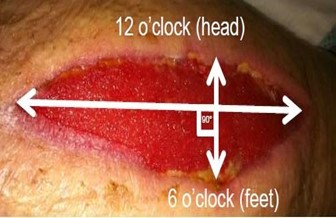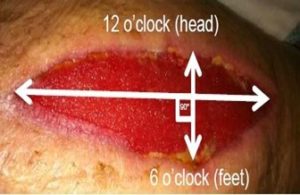


By Nancy Morgan, RN, BSN, MBA, WOCN
Each month Nancy Morgan Wound Care brings you a tool you can apply in your daily practice
Support Resources:
Infographics: Wound Measurement
Description

An essential part of weekly wound assessment is measuring the wound. It’s vitally important to use a consistent wound measurement technique every time you measure. The most common type of wound size measurement is linear measurement, also known as the “clock” method. In this technique, you measure the longest length, greatest width, and greatest depth of the wound, using the body as the face of an imaginary clock. Document the longest length using the face of the clock over the wound bed, and then measure the greatest width. On the feet, the heels are always at 12 o’clock and the toes are always 6 o’clock. Document all measurements in centimeters, as L x W x D. Remember—sometimes length is smaller than width. And if you have any other questions revolving around how to measure wound size, please see our advice below.
When measuring length, keep in mind that:
When measuring width:
When measuring depth:
We also need to measure undermining and tunneling. Measure undermining using the face of a clock as well, and measure depth and direction. Tunneling will measure depth and direction.
To measure undermining when doing wound measurement:
To measure tunneling:
What wound-measurement techniques are used in your setting? The clock method? Greatest length x width? Tracing? Do you find inconsistencies in wound measurement? Do all staff participate in wound measurement? Or are measurement and assessment done by designated staff on all shifts? Do you document on weekly tracking forms? Does your setting use narrative notes only?
Selected References
Wound Measurement & Documentation Guide. (2016, August 16). Health Quality Innovators
(HQI) for Centers for Medicare & Medicaid Services (CMS).
Mojica, Beatriz, LVN, WCC, CWCA, CSWS, DAPWCA. (2021, March 12). Measuring Wounds 101. Wound Clicks. Retrieved from https://woundclicks.com/wound-measuring-101-how-to-measure-wounds/
Nancy Morgan RN, BSN, MBA, WOCN is an experienced clinician, successful business leader, and accomplished nurse educator in the field of wound management. She is the co-founder of the Wound Care Education Institute, (WCEI®), Wild on Wounds Productions; and, most recently established Nancy Morgan Wound Care offering innovative, educational resources including wound measurement seminars, webinars, social media and wound care marketing tools to assist and support wound care clinicians at the bedside. Nancy is one of the most distinguished wound care educators, delivering nearly 1200 lectures, conference keynote addresses, seminars, webinars, and bedside consultations during her career.
Information is courtesy of Nancy Morgan Wound Care, copyright 2022.